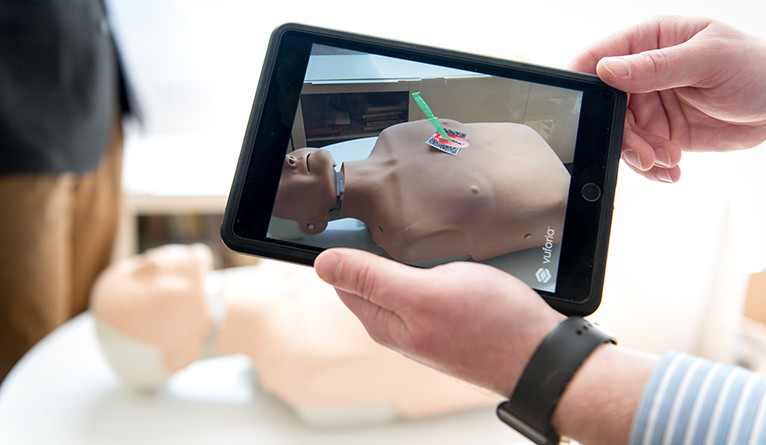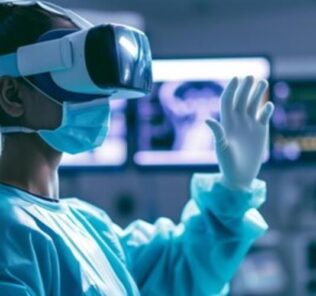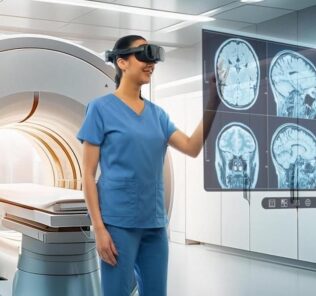Yale & HP Research Program Blends Reality to Bring New Perspective to Healthcare Simulation
Writer Mike Cummings’ recent article on Yale’s website entitled ‘Blended Reality’ Brings Diverse Perspectives to Emerging Tech, showcases a collaborative research program exhibition between Yale and HP that brings new perspectives to healthcare simulation technologies. While the full article linked below covers a range of unique creations, the augmented reality manikin from MSN student Travis MaCann caught our eye. Read more about their unique device from an excerpt of Mike’s article below!
Yale University and HP have partnered in an applied research program to explore the area of blended reality. Faculty and students work within this program will blur the lines between the physical and digital worlds, easing the transition of an idea from imagination, to design, to realization. The goal is to democratize 3D design, augmented reality, digital imaging and 3D fabrication technologies, removing the high learning bars that currently exist. This will open new creative outlets for artists, scientists, researchers and designers.
The work presented at the Center for Collaborative Arts and Media (CCAM) on April 26th was part of the Blended Reality Research Program — a partnership between Yale and HP supporting innovative, cross-disciplinary projects that blur lines between the physical and digital worlds. The program seeks to make emerging technologies, such as virtual and augmented reality, 3D fabrication, and digital imaging, accessible to a broader range of people, opening new creative avenues for artists and scholars, explained Justin Berry, the research program’s principal investigator and a critic at the Yale School of Art.
Sponsored Content:
“We’re trying to introduce this technology to people who don’t have expertise with it — people who are not approaching it with preconceived ideas about what it is supposed to become,” Berry said. “In doing so, we’re bringing diverse and unique perspectives to an emerging technology. Very often it’s people who aren’t familiar with technology who have the most meaningful insights about it.”
This diversity of perspectives was apparent in the broad range of projects presented at the event, which transported users inside the cell structure of a leaf, took them on a tour of an active Yale archaeological excavation in Egypt’s Elkab desert, or invited them to create a 3D selfie, among other experiences.
Travis McCann, who is studying for a master’s in science of nursing at the Yale School of Nursing, is collaborating with Yale undergraduate Bobby Berry to create dynamic medical-training simulations through augmented-reality technology, which unlike virtual reality uses real-world objects as part of the experience. Typically, medical training simulations are performed on manikins bearing wounds rendered with makeup. McCann and Bobby Berry, a senior majoring in computing in the arts, have created an app that uses augmented reality to simulate wounds and injuries on the mannequins more realistically.
“Before it was just makeup that looks like a cut,” said McCann, a teaching assistant in the School of Nursing’s simulation department. “With the augmented-reality headset, you can render an arterial bleed that will only stop once the student applies the correct treatment.”
Sponsored Content:
More realistic simulations will better prepare nursing students to respond effectively in genuine emergencies, McCann said. “The less shocking that first medical emergency seems, the more likely you are to respond correctly,” he said.
Read the Full Article on Yale’s Website!
Lance Baily, BA, EMT-B, is the Founder / CEO of HealthySimulation.com, which he started in 2010 while serving as the Director of the Nevada System of Higher Education’s Clinical Simulation Center of Las Vegas. Lance also founded SimGHOSTS.org, the world’s only non-profit organization dedicated to supporting professionals operating healthcare simulation technologies. His co-edited Book: “Comprehensive Healthcare Simulation: Operations, Technology, and Innovative Practice” is cited as a key source for professional certification in the industry. Lance’s background also includes serving as a Simulation Technology Specialist for the LA Community College District, EMS fire fighting, Hollywood movie production, rescue diving, and global travel. He and his wife live with their two brilliant daughters and one crazy dachshund in Las Vegas, Nevada.
Sponsored Content:


















